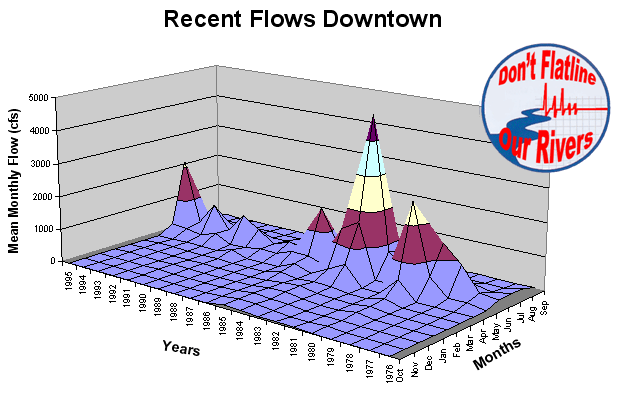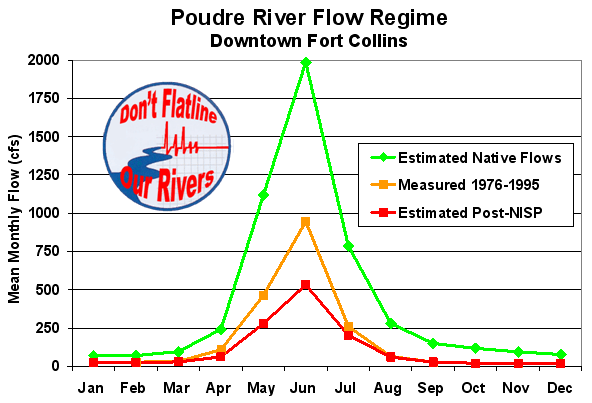The NISP/Glade project, a massive dam-and-reservoir project that would include the 177,000 acre-foot Glade Reservoir, is the largest engineering project proposed along Colorado’s Front Range in a quarter century. If built, the project would divert about 35% of the water out of the Poudre River as it flows through Fort Collins—and that is in addition to the 60% of water that is already diverted out of the Poudre. The ecological costs are even higher. Besides draining the Poudre to a trickle and threatening a variety of plant and animal species, the NISP/Glade project would severely deplete the already beleaguered “June Rise,” the natural increase in stream flows that occurs during snowmelt that is critical to the overall health of the Poudre River ecosystem.

In addition to the direct impacts to the river and its immediate ecosystem, the NISP project would have profound impacts on drinking water and waste water treatment, flood control, recreation, aesthetics and greenhouse gas emissions. In a nutshell, the NISP project would:
(1) introduce elevated amounts of total organic carbon into our drinking water systems resulting in far more costly water treatment, and potentially dangerous residual carcinogens;
(2) because of a decommissioned missile silo and Superfund site located in Glade Reservoir’s pumping area, there is the very real possibility that drinking water would be contaminated by the highly carcinogenic chemical known as TCE that is very difficult to manage;
(3) effluent from wastewater treatment facilities would no longer be guaranteed the meager dilution necessary to protect aquatic life and reduce nuisance odor problems, again elevating ratepayer costs;
(4) as with wastewater, reduced flows would exacerbate downstream problems with selenium, salinity and other water quality issues;
(5) reduced flows would cause vegetation to migrate into the existing river channel such that when the inevitable floods do occur, property damage would be much greater;
(6) reduced flows would elevate summer water temperatures putting ever more stress on the already vulnerable cold-water fishery and further violate existing water quality standards;
(7) the season for rafting and tubing would be severely reduced;
(8) large acreages of wetland and riparian areas would be at risk;
(9) and enormous pumps to fill Glade Reservoir would consume huge amounts of energy, leading to greenhouse gas emissions.
Concerns related to these and yet other issues have been thoroughly documented by the Cities of Fort Collins and Greeley. For example, please refer to http://fcgov.com/nispreview/, and by SaveThePoudre and others. The Colorado Water Quality Control Division made many of these same points in their comments to the Corps of Engineers. Though we do not know whether Kodak or Anheuser Busch provided any DEIS comments, it is certainly plausible that costs to treat their waste water and drinking water, respectively, would be elevated as a result of this project.
The Environmental Protection Agency has also commented extensively on the considerable negative environmental impacts that NISP would have and believes that it is highly unlikely that many of these issues could be satisfactorily mitigated. It has described the significant diminishment of water quality as well as the harm the project would have to fish, wildlife and riparian vegetation.
The objective of the Clean Water Act is to restore and maintain the chemical, physical, and biological integrity of the Nation’s waters. The proposed NISP project cannot ever lead to this objective. In short, if this project were built, subscriber communities would reap the benefits while local communities (Fort Collins, Greeley, Windsor, etc.) and businesses (e.g., Kodak, Anheuser Busch) would bear the costs, and the nation as a whole would lose a valuable resource. This is patently irresponsible for our environment, unfair to our citizens, and simply arrogant on the part of the Northern Colorado Water Conservancy District — especially when proven alternatives exist.
The following figures illustrate some of the impacts to the Cache la Poudre River’s health due to the proposed NISP and Glade Reservoir. These impacts are all related to alterations in the flow regime. Other reservoir development activities (Halligan, Seaman) may further exacerbate these problems.

To get a good feel for the impacts that NISP would have on the Poudre, you first need to understand what has already happened to the river. Let’s start with what the river flows looked like before large scale modifications. Shown here is a 20-year period, 1976-1995, along one horizontal axis, months in the year along the other (beginning with October, the first month in the USGS ‘water year’), and mean monthly flows on the vertical axis. The vertical color bands denote streamflow increments of 1,000 cubic feet per second (cfs). (Source: City of Fort Collins.)

Notice the significant reduction in the annual May-June snowmelt peaks compared with Figure 1-A. Naturally low winter-time flows are also extensively reduced. (Source: U.S. Geological Survey Lincoln Avenue gage.)

Notice the extreme reduction in peak flows that are so necessary to maintain the health of the river. Called “flushing flows,” these peak flows clean accumulated sediment and algae from the river’s bed and support a healthy, vibrant riparian community. USGS has calculated that flows to flush the Poudre River through Fort Collins must peak above 2,000 cfs. The river has been altered from a situation where flushing flows historically occurred 15 out of 20 years to the current situation where flushing flows happen about 10 out of every 20 years. If Glade is constructed, flushing flows at or above 2,000 cfs would be rare, occurring only about 5 years out of 20, essentially eliminating quality recreation along the river and turning the river into the same algal-clogged vestige found in Greeley today. (Source: hydrologic model of estimated NISP net diversions at or near Fort Collins.)

The same data given in Figure 1, presented as overall monthly averages, clearly shows that substantial flows have been diverted from the river through time. Native flows are those before man-made modifications; measured flows are those at the USGS gage in downtown Fort Collins; post-NISP flows are estimated from a model of diversions that NISP would remove from the river. If constructed, the NISP water development alone would markedly flatten the flow regime draining the life from our river. If yet other Poudre basin reservoirs are expanded, they too would worsen this flatlining.

Looked at yet another way, the NISP project, if constructed, would exacerbate the ongoing trend of reducing annual peak daily flows necessary to sustain a healthy riverine and riparian ecosystem. The dashed trend line is the 90% quantile representing the approximate decline in snowmelt-driven peak flow events through time.

We divert substantial flows below the mouth of the Cache la Poudre canyon. If constructed, NISP would further reduce flows not only near I-25, but as far downstream as Nebraska. Cumulatively, the projected flow changes significantly affect the river’s ability to flush harmful sediment from it’s bed, drain water away from valuable riparian (treed) areas along the stream, and dewater legally-defined wetlands in or near the river’s channel.

Water quality in the Cache la Poudre River is flow-dependent. Data suggest that the lower the flow, the greater the probability of high levels of nutrients such as ammonia (shown here) and other aquatic system toxins.

Because we already divert substantial flows from the Cache la Poudre River, and because of sewage treatment and associated urbanization, water quality declines dramatically from the relatively pristine high mountain runoff out into the plains. If the NISP project is constructed, decreased river flows, especially in low flow months, would exacerbate nutrient enrichment.

Colorado’s rivers and streams have become more polluted over the last few years, with an increasing percentage found impaired for swimming and fishing—now 14 percent up from 9 percent just 5 years ago. Impaired waters include the Green River and Arkansas basin. (http://environmentcolorado.org/newsletters/fall06/article3.html)
Impacts to Working Farms and Ranches
SaveThePoudre’s principal focus has been on the river and its environs, but we are saddened by the spin that the Northern Colorado Water Conservancy District has put on the issue of loss of irrigated agricultural lands. A central ‘selling point’ of the District’s is that NISP would protect agricultural lands. Their ‘logic’ is that if the growing communities in Northern Colorado cannot take the last water out of the Poudre, they would instead take it from farmers, dooming the land to dry up. What they don’t say is that these same communities would continue to grow onto and develop vast amounts of working farms and ranches (including wetlands associated with those lands) converting green space to rooftops, concrete and asphalt. The draft EIS’s stated Purpose and Need says nothing about saving agricultural land; instead it is clear that the water would be used for regional growth. SaveThePoudre has never been against growth per se, but we find the Northern District’s consistent message about ‘saving agricultural land’ deceitful at best.
For much more on these issues, please see The Farm Facts and our list of top reasons to oppose NISP.
